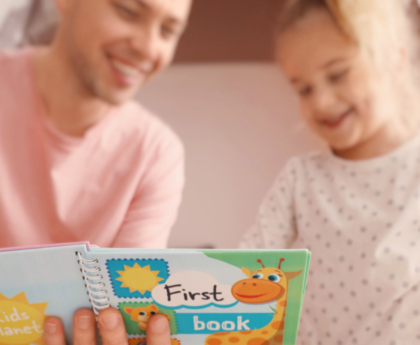Your child has mastered basic letter sounds and can read simple words like “cat” and “dog.” Then they encounter “car” and suddenly freeze. Welcome to the world of r-controlled vowels—one of the trickiest concepts in early reading that leaves many parents scratching their heads. But here’s the good news: with the right approach, you can help your child conquer these “bossy R” sounds and unlock a whole new level of reading confidence.
What Are R-Controlled Vowels and Why Do They Matter?
R-controlled vowels occur when the letter “r” follows a vowel, fundamentally changing how that vowel sounds. Instead of making their usual short or long sounds, vowels become “controlled” by the r, creating entirely new sounds that children must learn separately.
The five main r-controlled vowel patterns are:
- ar (as in car, star, park)
- er (as in her, fern, clerk)
- ir (as in bird, girl, shirt)
- or (as in for, corn, sport)
- ur (as in fur, turn, hurt)
These patterns represent approximately 8% of all English words, making them essential for reading fluency. Children who struggle with r-controlled vowels often find themselves stuck when encountering common words like “water,” “sister,” “turtle,” and “farmer.”
The challenge lies in the fact that these sounds don’t follow the typical vowel rules children have already learned. When a child sees “car,” they might try to apply the short “a” sound they know, resulting in confusion and frustration. This is why systematic instruction in r-controlled vowels is crucial for reading development.
Children typically encounter r-controlled vowels in late first grade or early second grade, after they’ve mastered basic consonant-vowel-consonant (CVC) patterns. However, many reading programs don’t provide sufficient explicit instruction in these patterns, leaving children to figure them out through guesswork.
When Children Typically Learn R-Controlled Vowels
Most children are developmentally ready to tackle r-controlled vowels between ages 6-8, typically after they’ve mastered basic phonics patterns and can read simple CVC words fluently. However, readiness varies significantly among individual children.
Before introducing r-controlled vowels, your child should demonstrate a solid understanding of:
- Short vowel sounds in CVC words
- Basic consonant blends
- The concept that letters work together to make new sounds
- Ability to segment and blend sounds in words
Signs your child is ready include reading simple books independently, recognizing common sight words, and showing curiosity about more complex words they encounter in stories.
Some children may be ready earlier, while others need more time with foundational skills. Pushing too early can create confusion and negative associations with reading, so it’s important to ensure your child has a solid foundation before moving forward.
The Systematic Approach to Teaching R-Controlled Vowels
The most effective way to teach r-controlled vowels follows a systematic, explicit approach that builds understanding step by step. Start with the most common and distinct patterns before moving to more challenging ones.
Step 1: Introduce the concept
Begin by explaining that when “r” comes after a vowel, it changes the vowel’s sound completely. Use the analogy of “bossy R” taking over and making the vowel sound different. This helps children understand why familiar rules no longer apply.
Step 2: Start with “ar”
Begin with the “ar” pattern because it produces the most consistent and recognizable sound. Use clear examples like “car,” “jar,” “star,” and “park.” Practice the sound in isolation first, then in simple words.
Step 3: Add “or” pattern
Once “ar” is solid, introduce “or” words like “for,” “corn,” “born,” and “short.” These two patterns are most distinct from each other, making them easier to differentiate.
Step 4: Tackle the tricky trio
The “er,” “ir,” and “ur” patterns all make the same sound, which can be confusing. Introduce them together, emphasizing that while they look different, they sound the same. Start with “er” words like “her” and “fern,” then add “ir” words like “bird” and “girl,” followed by “ur” words like “fur” and “turn.”
Step 5: Practice and reinforce
Provide plenty of opportunities to read r-controlled vowel words in isolation and in context. Use decodable books that feature these patterns prominently.
Multi-Sensory Activities That Make Learning Stick
Children learn r-controlled vowels best when multiple senses are engaged simultaneously. These hands-on activities help cement the learning in ways that traditional worksheets cannot.
Letter manipulation activities work exceptionally well. Have your child build words with magnetic letters or letter tiles, physically moving the “r” next to different vowels to see how the sound changes. This tactile experience reinforces the concept that “r” controls the vowel.
Sound sorting games help children distinguish between different r-controlled patterns. Create picture cards or word cards for each pattern and have your child sort them into categories. Start with just two patterns (like “ar” and “or”) before adding more.
Writing in textured materials engages the tactile system while reinforcing letter formation. Have your child write r-controlled vowel words in salt trays, finger paint, or sand while saying the sounds aloud.
Rhyming activities specifically focused on r-controlled vowels help children recognize patterns. Create rhyming families like “car, far, star, jar” or “bird, heard, word.” This builds both phonemic awareness and pattern recognition.
Common Mistakes and How to Address Them
Even with systematic instruction, children commonly make predictable errors when learning r-controlled vowels. Understanding these mistakes helps you provide targeted support.
Reverting to short vowel sounds is the most frequent error. When children see “car,” they might pronounce it as “cat” with a short “a” sound. This happens because they’re applying previously learned rules. Gently remind them that “r” changes everything and have them practice the correct pronunciation.
Confusing “er,” “ir,” and “ur” patterns is completely normal since they all make the same sound. When your child spells “bird” as “berd,” acknowledge that they heard the sound correctly but need to remember the correct spelling pattern. Create memory devices like “The girl has a bird” to help with visual memory.
Adding extra sounds sometimes occurs when children overemphasize the “r.” If they’re saying “car-uh” instead of “car,” model the correct pronunciation and have them practice blending the sounds smoothly together.
Inconsistent application happens when children can read r-controlled vowels in familiar words but struggle with new ones. This indicates they’ve memorized specific words rather than truly understanding the pattern. Provide more practice with varied examples to build pattern recognition.
Build Fluency Through Strategic Practice
Once your child understands r-controlled vowel patterns, building fluency requires consistent, varied practice that moves from simple to complex applications.
Start with word lists that focus on one pattern at a time. Have your child read lists of “ar” words, then “or” words, gradually building speed and accuracy. Time them occasionally to build automaticity, but keep it fun and pressure-free.
Progress to phrase reading using r-controlled vowel words in simple phrases like “the red barn,” “her first turn,” or “a smart shark.” This bridges the gap between isolated words and full sentences.
Use decodable sentences that feature multiple r-controlled vowels: “The girl saw a bird in the park.” These sentences allow children to practice the patterns in context while building comprehension skills.
Incorporate repeated readings of favorite books that contain many r-controlled vowel words. Popular choices include books about farms, animals, or adventures that naturally include these patterns.
Advanced R-Controlled Vowel Patterns
Once your child masters basic r-controlled vowels, they’ll encounter more complex patterns that follow the same principles but require additional instruction.
Two-syllable words with r-controlled vowels appear frequently in children’s reading: “water,” “winter,” “summer,” “mother.” Practice dividing these words into syllables and identifying the r-controlled vowel pattern in each syllable.
Compound words often contain r-controlled vowels: “farmyard,” “cornerstone,” “horseback.” Help your child break these into smaller parts and identify familiar patterns within the larger word.
Words with multiple r-controlled vowels like “porcupine” or “carpenter” require careful attention to each pattern within the word. Practice these systematically, identifying each r-controlled vowel separately.
Silent letter combinations sometimes appear with r-controlled vowels, as in “warm” or “work.” These require explicit instruction as they don’t follow typical patterns.
Choose the Right Materials and Resources
Selecting appropriate materials significantly impacts your child’s success with r-controlled vowels. Look for resources that provide systematic, explicit instruction rather than expecting children to discover patterns independently.
Decodable books specifically designed for r-controlled vowel practice are invaluable. These books use carefully controlled vocabulary that allows children to practice new patterns without being overwhelmed by unfamiliar words or concepts.
Phonics programs that follow a systematic scope and sequence ensure your child encounters r-controlled vowels at the appropriate time and with sufficient practice. Avoid programs that expect children to memorize whole words or use context clues to guess unfamiliar words.
Interactive apps and games can provide additional practice, but ensure they focus on systematic phonics instruction rather than whole-word recognition. The most effective digital tools allow children to manipulate sounds and letters while receiving immediate feedback.
Mastering R-Controlled Vowels Opens Reading Doors
R-controlled vowels represent a crucial stepping stone in your child’s reading development. While they may seem challenging at first, systematic instruction and consistent practice will help your child master these important patterns.
Remember that every child learns at their own pace, and temporary confusion is completely normal. With patience, encouragement, and the right instructional approach, your child will soon read r-controlled vowel words with confidence and fluency.
The key is providing explicit, systematic instruction that builds understanding step by step, rather than expecting your child to figure out these complex patterns on their own. When children truly understand how r-controlled vowels work, they unlock access to thousands of new words and significantly improve their reading fluency.
Ready to give your child the systematic phonics instruction they need to master r-controlled vowels and beyond? The Reading.com app provides structured, sequential lessons that teach these challenging patterns through engaging, multi-sensory activities designed for lasting success. Start your free 7-day trial today and watch your child’s reading confidence soar as they master even the trickiest vowel patterns.





